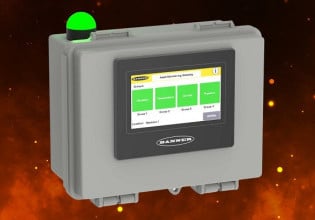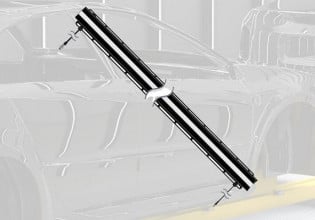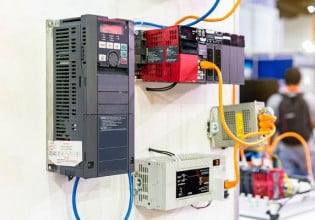Understanding Microelectromechanical System (MEMS) Sensors
MEMS sensors enable the creation of highly sensitive, compact, and low-power devices for measuring quantities like acceleration, magnetic fields, pressure, and more, and are found in automotive safety systems, navigation, and environmental monitoring.
See Our Previous Articles on Industrial Sensors:
- Temperature Sensors and Their Uses
- Magnetic and Inductive Sensing
- Pressure Sensor Fundamentals and Types
- Level Sensors For Use in Level Measurement
- Flow Rate Sensors for Fluid System Measurement
Microelectromechanical system (MEMS) sensors are a big part of the semiconductor world. These MEMS are miniature devices that combine electrical and mechanical components to perform various tasks, most often for sensing. These devices are fabricated using the same processes as semiconductors, which makes them highly compatible with existing microelectronics technologies. MEMS are also highly scalable.
MEMS systems have many applications, including automotive, biomedical devices, consumer electronics, and aerospace industries. In addition, they are crucial for the development of autonomous driving vehicles.

Figure 1. MEMS systems are in the scale and size of semiconductors. Image used courtesy of Micralyne
MEMS sensors enable the creation of highly sensitive, compact, and low-power devices for measuring many different physical quantities. These physical quantities include temperature, acceleration, magnetic fields, pressure, and more. Like MEMS systems, these sensors are prominent in automotive safety systems, navigation, and environmental monitoring.
The purpose of a MEMS sensor is to convert a physical stimulus into an electric signal by using specialized microelectromechanical structures and components. These structures are built into a thin film using semiconductor techniques to produce tiny mechanical devices capable of performing complex functions with high accuracy. Some of these structures range in size from micrometers and even nanometers. MEMS sensor structures are integrated with additional electronics for readout and to provide electrical outputs.
In the next sections, we will review some of the most common types of MEMS sensors found today, including accelerometers, magnetometers, impact sensors, temperature sensors, and more.
Accelerometer
Accelerometers are one of the most common types of MEMS sensors. They measure the acceleration of a body or an object based on the displacement of a mass. This mass displacement is detected using a capacitive or piezoresistive sensing element that generates an electrical signal proportional to the acceleration. To do this, miniature flexible beams suspend a small mass. When the device moves, the small mass moves and flexes the suspending beams. Flexion changes are then used to calculate the acceleration.

Figure 2. A diagram of a three-axis accelerometer. Image used courtesy of GlobalSpec
Accelerometers are important devices found in many of the devices we use in our daily lives. Some examples of applications include smartphone motion sensing, drone control and stabilization, medical devices, vibration sensors in industrial environments, and automobile safety systems.
Magnetometer
These sensors are capable of detecting and measuring the strength of magnetic fields. Magnetometers are useful to determine the orientation and movement of an object. They are fabricated using thin films of magnetic material deposited on a silicon substrate and patterned into specific shapes. Then, a current is passed through the magnetic material, generating magnetic fields. External magnetic fields applied to the sensor change the magnetometer’s fields, which is detected as a change in output voltage.

Figure 3. MEMS magnetometers are used in applications like mobile phone compasses, where GPS direction tracking may not be sufficient. Image used courtesy of Adobe Stock
Magnetometers can be found in numerous applications, including compasses and navigation systems. In addition, they are widely used in the mobile devices industry.
Crash and Impact Sensor
These MEMS sensors are primarily used in automotive safety to detect collisions and trigger safety measures such as airbags. Impact sensors consist of a silicon chip configured with numerous mechanical structures that deform due to mechanical shock. These structures are coated with a piezoelectric material, which helps convert the mechanical energy into an electric output.

Figure 4. Car safety features like airbags rely on impact MEMS sensors to react quickly. Image used courtesy of Adobe Stock
MEMS Temperature Sensor
The foundational mechanical structure of these sensors is made of temperature-sensitive materials that expand or contract upon temperature changes. These structures are shaped like diaphragms or beams and are coated with a metallic layer that changes its electrical resistance due to the diaphragm’s changes in shape.
Temperature MEMS sensors are widely regarded as reliable and can be found in many applications. Some of their applications include HVAC systems, medical devices, and industrial process control.
Inertial Measurement Unit (IMU) Sensor
IMUs are hybrid sensors combining accelerometers and gyroscopes to measure orientation, velocity, and acceleration accurately. These sensors are typically built using three accelerometers and three gyroscopes. The accelerometers measure linear acceleration in three dimensions, while the gyroscopes measure angular velocity in three axes. The working principles of IMUs are the same ones behind accelerometers and gyroscopes.
IMUs can be found in robotics applications, drones, and advanced navigation systems.

Figure 5. The relative size of an IMU MEMS sensor. Image used courtesy of Gladiator Technologies
MEMS Pressure Sensor
The structures in these sensors consist of diaphragms that deform in response to changes in pressure. The diaphragms are coated with a layer of materials that change their electrical resistance depending on the deformation of the diaphragm. As a result, these sensors are regarded as accurate but can be affected by temperature changes.
Sensors In Industrial Automation
In the next installment in our series, we will look at position and distance sensors and the common types used in automation.






